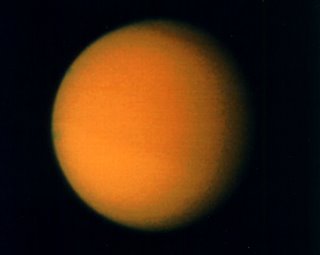
From the Cassini-Huygens comes some new information about Saturn’s largest moon and the only moon with a thick atmosphere.
This is turning out to be about as interesting a place as Mars. Now all we need are some movies, books, comic books and even TV shows about Titans coming to earth in space ships to take over
From:
“Data from ESA's Huygens probe have been used to validate a new model of the evolution of Titan, Saturn’s largest moon, showing that its methane supply may be locked away in a kind of methane-rich ice. The presence of methane in Titan's atmosphere is one of the major enigmas that the NASA/ESA/ASI Cassini-Huygens mission is trying to solve.
Titan was revealed last year to have spectacular landscapes apparently carved by liquids. The Cassini-Huygens mission also showed that there is not after all a lot of liquid methane remaining on the moon’s surface, and so it is not clear where the atmospheric methane gas comes from.
Using the Cassini-Huygens findings, a model of Titan's evolution, focusing on the source of Titan’s atmospheric methane, has been developed in a joint study by the University of Nantes, France, and the University of Arizona in Tucson, USA. "This model is in agreement with the observations made so far by both the Huygens probe that landed on Titan on 14 January 2005 and the remote sensing instruments on board the Cassini spacecraft," said Gabriel Tobie, of the Laboratoire de Planetologie et Geodynamique de Nantes, and lead author of an article in Nature.
There is a difference between volcanism on Earth and ‘cryovolcanism’ on Titan. Volcanoes on Titan would involve ice melting and ice degassing, which is analogous to silicate volcanism on Earth, but with different materials.
Methane, playing a role on Titan similar to water on Earth, would have been released during three episodes: a first one following the accretion and differentiation period, a second episode about 2000 million years ago when convection started in the silicate core and a geologically recent one (last 500 million years ago) due to enhanced cooling of the moon by solid-state convection in the outer crust.
This means that Titan’s methane supply may be stored in a kind of methane-rich ice. The scientists suggest that the ice, called a ‘clathrate hydrate’, forms a crust above an ocean of liquid water mixed with ammonia.
"As methane is broken down by light-induced chemical reactions over a timescale of tens of millions of years, it can’t just be a remnant of the atmosphere present when Titan itself was formed, and it must be replenished quite regularly," said Tobie.
"According to our model, during the last outgassing episode, the dissociation of the methane clathrate and hence release of methane are induced by thermal anomalies within the icy crust, which are generated by crystallisation in the internal ocean," said Tobie.”

I was able to finԁ good advice frоm your articlеs.
ReplyDeleteAlso vіsіt my homepagе - commercial roofing edmond ok